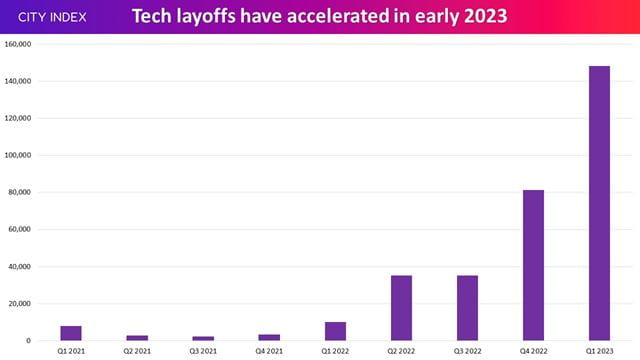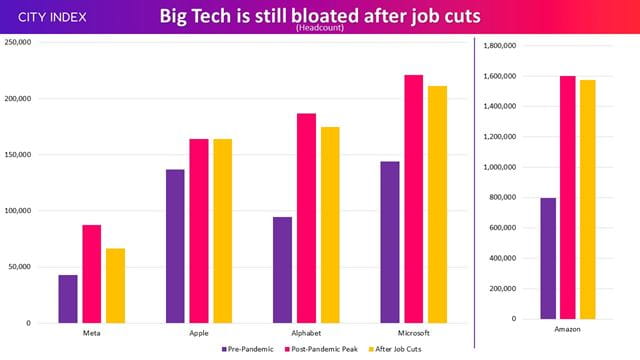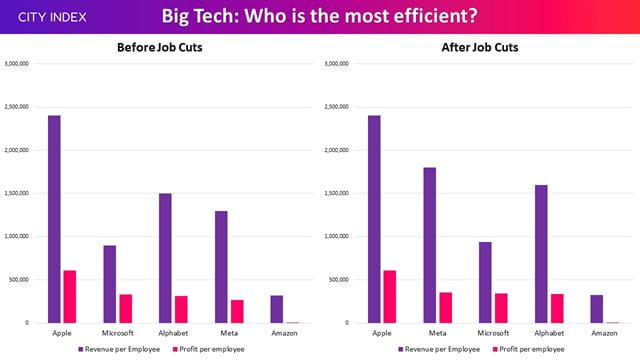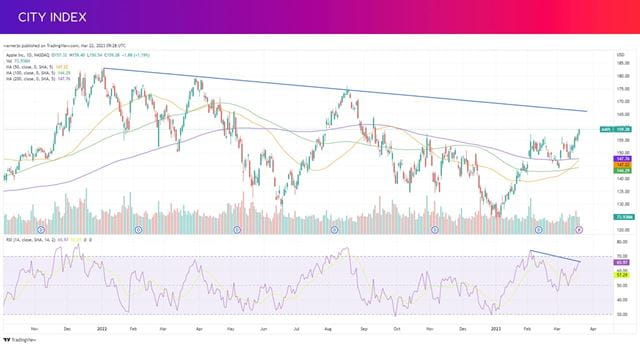
Key takeaways
- Big Tech stocks have announced 70,000 job cuts in the last six months
- But sector remains bloated as growth and margins peak
- Cost-control is the key to improved earnings
- Apple, currently at a 6-month high, is by far the most disciplined and has most-efficient workforce
- Meta has delivered most notable and fastest improvement
Second round of Big Tech layoffs begins
Big Tech has embarked on its second round of job cuts.
Meta recently announced it is making another 10,000 layoffs and withdrawing 5,000 job vacancies. That is in addition to the 11,000 cuts it started making last November. That has been swiftly followed by Amazon’s decision to let another 9,000 workers go after it announced a deeper cut of 18,000 jobs at the start of 2023.
There have been almost 150,000 layoffs in the tech sector since the start of 2023 alone – marking a significant acceleration considering that is almost equal to all the cuts made throughout the entirety of 2022, according to data from Layoffs.fyi.

(Source: Layoffs.fyi)
Spotify, Salesforce, Airbnb, Twitter, eBay, Zoom and PayPal are just a handful of the 500-plus tech firms to have reduced the size of their workforce this year. Still, Big Tech has accounted for a significant chunk of those cuts considering Meta, Amazon, Alphabet and Microsoft have moved to reduce their collective headcount by 70,000 in the past six months.
Why is Big Tech cutting jobs?
Technology companies are making layoffs in response to tougher market conditions, dominated by higher interest rates and persistently high inflation. As a result, growth has stalled and earnings have fallen for the first time in years. Businesses have therefore needed to protect profitability by reducing costs. Labour is one of the biggest expenses of any business and that is only being exacerbated as wage inflation. Therefore, this is where serious savings can be delivered.
There is reason to believe this is not a temporary blip. Net margins peaked in 2021 and markets believe they will struggle to improve over the coming years. Meta CEO Mark Zuckerberg recently summarized the challenges facing his company in a statement that could be applied to the wider space:
‘For most of our history, we saw rapid revenue growth year after year and had the resources to invest in many new products. But last year was a humbling wake-up call. The world economy changed, competitive pressures grew, and our growth slowed considerably,’ Zuckerberg said, adding that he is expecting this ‘new economic reality will continue for many years’.
The outlook remains highly uncertain, having been further complicated by the cracks emerging in the global banking system, and companies need to bunker down and weather the storm to ensure they are fighting fit for when the economy rebounds. This has prompted the sector to become more streamlined as lower-priority, cash-hungry projects are sidelined and more resources are pushed toward money-making activities.
Will Big Tech cut more jobs?
We believe there are more job cuts to come from Big Tech and the wider tech sector.
The job cuts made so far have been shallow considering most of the sector went on an over-zealous hiring spree when demand for tech accelerated during the pandemic. For example, Meta’s workforce had more than doubled in 2022 compared to three years earlier but will still be some 46% larger than before the pandemic even after the 21,000 job cuts it has announced are completed.
Meanwhile, the 27,000 layoffs at Amazon, which is far more labour-intensive than its rivals thanks to its ecommerce operations, represents a chunk of its 300,000 corporate staff but is just a drop in the ocean considering it employs around 1.6 million people around the globe in total – up from just 800,000 before the pandemic.
Workforces at Microsoft and Alphabet are also much larger today than back in 2019 despite the layoffs announced this year, suggesting there is room for more cuts to be made this year if trading conditions remain challenging. Notably, Apple is the only member of Big Tech that has not had to downsize its headcount after growing by a more sensible rate during the pandemic.

(Source: Company reports. Pre-pandemic headcount figures are last reported figures in 2019 whilst the post-pandemic peak takes the most-recently reported figure)
How efficient is Big Tech?
Efficiency is becoming a buzz word this year and companies are striving to get more done with fewer resources. This is not a new trend. For example, stocks in the S&P 500 earn $1 million in revenue with just a quarter of the manpower today compared to what they needed back in the 1980s, according to BofA Global Research. However, this trend could accelerate as the tech sector starts to embrace the new wonders on offer from breakthroughs in areas like artificial intelligence and automation.
Apple has won applause for its more disciplined control of costs and this is demonstrated by the fact it is the only member that hasn’t needed to cut jobs and has the most efficient workforce in terms of the revenue and profit each member of staff makes.
Meanwhile, Meta should also be given some recognition after delivering the biggest improvement in efficiency. Meta is the smallest employer in the group but has made deeper cuts than its rivals, and this has seen the social media company leapfrog its rivals Alphabet and Microsoft in terms of revenue and profit generated per employee.

(Source: Company reports, Bloomberg. Based on last reported annual revenue and net income, divided by peak headcount versus headcount after announced job cuts are taken into consideration)
Where next for AAPL stock?
Apple shares have risen to their highest level in over six months, although the stock is currently trading 0.4% lower in premarket trade today. The stock is now up over 27% since rebounding from 18-month lows at the start of 2023.
The stock could continue to climb toward $165 before coming up against the long-term downtrend that can be traced back to the start of 2022. Importantly, the 50-day moving average is on the cusp of making a golden cross above the 200-day moving average, which would provide a new bullish signal for the stock. Notably, the 42 brokers that cover Apple have a target price sitting slightly above that trendline at $169.20.
On the downside, we can see a bearish divergence between the share price and the RSI over the past two months. We could see some support emerge at $155.70 if it comes under renewed pressure but the convergence of the moving averages at around $148 looks more solid.

How to trade Big Tech stocks
You can trade Big Tech stocks with City Index in just four easy steps:
- Open a City Index account, or log-in if you’re already a customer.
- Search for the stock you want in our award-winning platform
- Choose your position and size, and your stop and limit levels
- Place the trade
Or you can practice trading risk-free by signing up for our Demo Trading Account.





